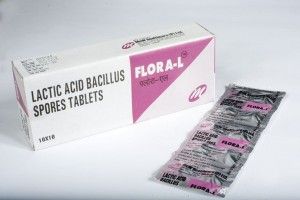Flora – L
Each uncoated tablet contains:
Lactic Acid Bacillus Spores 150 million
Description
Lactobacillus acidophilus is a bacteria that exists naturally in the body, primarily in the intestines and the vagina. Lactobacillus acidophilus helps maintain an acidic environment in the body, which can prevent the growth of harmful bacteria.
Research has indicated that L. acidophilus provides additional health benefits, including improved gastrointestinal function, a boosted immune system, and a decrease in the frequency of vaginal yeast infections. L. acidophilus also provides relief from indigestion and diarrhoea.
Antibiotics are one of the important pharmaceuticals in the control of microorganisms. Antibiotic kills friendly and non- friendly bacteria in human gut.
Lactobacilli being the predominant organism in the normal bacterial flora of the gut, are the most severely affected by antibiotic treatment. In the absence of Lactobacilli, antibiotic resistant pathogens increase in numbers and may flourish in the gut. They multiply rapidly, causing both systemic and oral disturbances. Lactobacilli check the growth of putrefying microflora of the gut and control production of ammonia, toxic amines, phenols and hydrogen sulphide.
Lactobacilli increase the activity of useful enzymes e.g., B- galactosidase in the alleviation of Lactose Intolerance.
Mode of Action
1. Production of inhibitory substances
Friendly bacteria of the gut produce a variety of substances that are inhibitory to both gram positive and gram negative bacteria. They produce antimicrobial compounds (bacteriocins), volatile fatty acids, organic acids, and lactic acid, which reduce the intestinal pH. These compounds reduce the number of viable pathogenic organisms in the GI tract.
2. Blocking of adhesion sites
Friendly bacteria of gut compete directly with pathogenic organisms of epithelial attachment sites in the GI tract, thereby preventing attachment and colonization of the GI tract by the potentially pathogenic organisms.
3. Competition for nutrients
High multiplication rate of friendly bacteria results in competition for available nutrients leading to suppression of pathogens.
Indications
- Mild to moderate Diarrhoea
- Antibiotic associated Diarrhoea
- Co-prescription with antibiotics
- Constipation
- Leucorrhoea
- PID
- Bacterial Vaginosis
Dosage & Administration
For Infants: 50 million spores tid i.e., Flora – L 1/2 tab. 3 times a day
For Children: 50-100 million spores tid i.e., Flora – L ½ to 1 tab. 3 times a day
For Adults: 100-200 million spores tid i.e., Flora – L 1 tab. 3 times a day
Dosage in Leucorrhoea
One tablet bid for 15 days followed by one tablet od for a month.
Packing:
Strip of 10 tab. Box of 10 strips


